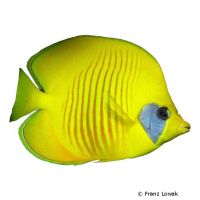Golden Butterflyfish (Chaetodon semilarvatus)
| Golden Butterflyfish Chaetodon semilarvatus | |
|---|---|
| Name | Golden Butterflyfish |
| Name Lat. | Chaetodon semilarvatus |
| Family | Butterflyfishes |
| Family lat. | Chaetodontidae |
| Order | Surgeonfishes |
| Order lat. | Acanthuriformes |
| Origin | Red Sea, Gulf of Aden |
| Habitat | Coral reefs |
| Diet | Omnivore |
| pH | 8.1-8.4 |
| Hardness | 8-10 °KH |
| Behavior | Peaceful |
| Keeping | Individual, pair |
| Reef Compatible | With caution |
| Care Level | Difficult |
| Life Span | 5-7 years |
| Protection | No |
| Metric Units | |
| Size | 23 cm |
| Temperature | 23-28 °C |
| Salinity | 33-36 ‰ |
| Aquarium | ~ 750 l |
| US Units | |
| Size | 9" |
| Temperature | 73-82 °F |
| Salinity | 1.020-1.025 sg |
| Aquarium | ~ 200 gal |
Distribution and habitat
The distribution area of Chaetodon semilarvatus, also called "Maskarill", is the Red Sea, the Gulf of Aden and the Gulf of Oman. There they live in pairs or in small groups on coral-rich reefs.
Maintenance
They require a well-structured aquarium with plenty of swimming space and a reef structure (hiding, resting and retreat possibilities) with living stones which they can graze on and which act like a biological filter. Only lime-rich, heavy metal-free substrates may be used as substrate
Filters, skimmers and heaters are necessary to ensure water quality, as well as pumps to simulate tides, swells and bottom currents. Lighting must match the species-appropriate day-night rhythm of the animals
| Salinity: 33-36 ‰ | pH value: 8.1-8.4 |
| Carbonate hardness: 8-10 °KH | Nitrate content: 2-8 mg/l |
| phosphate content: 0.01-0.1 mg/l | nitrite content: 0.0-0.05 mg/l |
For salinity, an average value should be aimed for, which may only vary slightly by +/- 0.5 ‰. Ammonia and ammonium must not be measurable. Special attention must be paid to constantly good water quality.
Diet
They are permanent eaters, feeding on small crustaceans and algae as well as coral polyps. The food change usually succeeds with stress-free acclimation without problems. The food supply should consist of a commercially available, vitamin-enriched frozen special food mix or a combination of algae (e.g. spirulina, kelp), chopped shrimp, squid and mussel meat with live and frozen food, such as mysis, krill, bosmids and artemia, as well as live cyclops, which also serve to keep them busy. It is recommended to feed small portions several times a day (3-5 times)
Regular and varied feeding promotes health and increases resistance.
Behaviour and compatibility
It is recommended to keep them in pairs or in a group. To avoid ranking fights, two animals of different sizes or two juveniles should be placed in the aquarium at the same time. The dominant, larger animal always develops into the male. They should only be socialized with calm, peaceful fish, as they are very susceptible to stress.
Sex dimorphism
Presumably, all butterflyfishes are sequential hermaphrodites, meaning they possess both male and female sexual expressions. External sexual characteristics are not known.
Reproduction and breeding
There are no known reports of successful breeding in the aquarium.
Important
As reef dwellers, they should not be kept in a fish-only aquarium. If kept in pairs, with sufficient activity (live stones) and varied feeding, they can be well maintained in a reef aquarium. When socialized with too lively or aggressive fish, they sometimes stop feeding
If different species are kept together, care should be taken to ensure that the fish match each other in terms of water quality and temperature requirements and social behavior, and that the setup meets the needs of all species kept together. New fish to be introduced must be acclimated slowly to the water in the aquarium
Further literature can be found in your pet store.
References
Text: Werner Knapp; Image: Franz Lowak
Source: KUITER, DEBELIUS (2007): Atlas der Meeresfische: Die Fische an den Küsten der Weltmeere, Kosmos Verlag; ENGELMANN (2005): Zootierhaltung - Tiere in menschlicher Obhut: Fische, Verlag Harri Deutsch
- Gemäß § 21 Abs. 5 Tierschutzgesetz idgF
